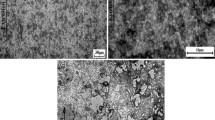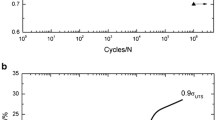Abstract
Fractographic analysis of SCS-6/Ti-24Al-11 Nb(a/o) (Ti-24-11 hereafter) and SCS-6/Ti-1 5V- 3Cr-3Al-3Sn(w/o) (Ti-15-3 hereafter) composites subjected to fatigue crack growth conditions indicates that the interface is prone to wear damage as a result of fiber/matrix sliding. In this study, the effect of fatigue loading on the integrity of the Interface was studied by using fiber pushout testing to compare the interfacial shear strength of composite specimens in the asreceived condition with specimens that were previously subjected to fatigue loading. Fatigue loading was also simulated by pushing fibers back and forth (multiple reverse pushouts). It was concluded that interfacial sliding during fatigue loading results in interfacial damage and degradation of the interfacial shear strength. Tensile testing of extracted fibers exposed to fatigue-induced interfacial damage was also performed to determine the effect of interface damage on the fiber strength. Interfacial damage also resulted in decreased fiber strength of the SCS-6 fiber. Fracture and wear of the outer carbon coatings on the SCS-6 fiber is the main contributing factor in the deterioration of these interfaces.
Similar content being viewed by others
References
P.T. Kantzos, MS Thesis, The Pennsylvania State University, Metals Science and Engineering (1991).
M.D. Sensmeier, and P.K. Wright, “The Effect of Fiber Bridging on Fatigue Crack Growth in Titanium Matrix Composites,” Fundamental Relationships between Microstructure & Mechanical Properties of Metal-Matrix composites, P.K. liaw and M.N. Gungor, eds., The Minerals, Metals & Materials Society, 1990.
D. L. Davidson, K.S. Chan, and J. Lankford, “Crack Growth Processes at Elevated Temperatures in Advanced Materials, AFSOR ANNUAL REPORT FOR 1989, F4962ac9-89-C-0032, Jan. 1990.
J.I. Eldridge, R.T. Bhatt, and J.D. Kiser, Ceram. Eng. Sci. Proc. 12 1152 (1991).
X.J. Ning, P. Pirouz, K.P.D. Lagerlof, and J. DiCarlo, “The Structure of Carbon in Chemically Vapor Deposited SiC Monofilaments,” J. Mater., Vol. 5, No. 12, Dec. 1990.
K.S. Chan, “Effects of Interface Degradation on Fiber Bridging of Composite Fatigue Cracks,” (To be Published).
D.B. Marshall, M.C. Shaw, and W.L. Morris, “Measurement of Interfacial Properties in Intermetallic Composites,” Titanium Aluminide Composite Proceedings, P.R. Smith, S.J. Balsome, and T. Nicholas, eds., WL-TR-91-4020, Feb. 1991.
J.I. Eldridge, “Fiber Push-out Testing of Intermetallic Matrix Composites at Elevated Temperatures,” MRS Spring Meeting, San Francisco CA. Apr. 1992.
W.C. Revelos and P.R. Smith, Metall. Trans. A, Volume 23A, 1992.
Author information
Authors and Affiliations
Rights and permissions
About this article
Cite this article
Kantzos, P., Eldridge, J., Koss, D.A. et al. The Effect of Fatigue Loading on the Interfacial Shear Properties of SCS-6/Ti-Based MMCS. MRS Online Proceedings Library 273, 135–142 (1992). https://doi.org/10.1557/PROC-273-135
Published:
Issue Date:
DOI: https://doi.org/10.1557/PROC-273-135




